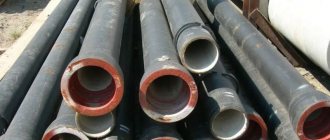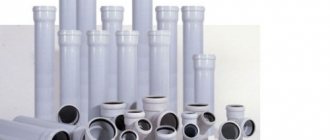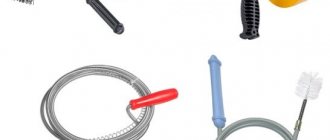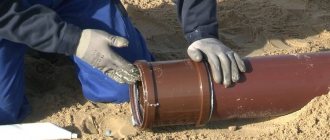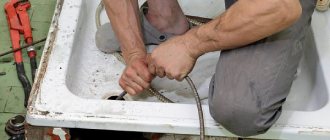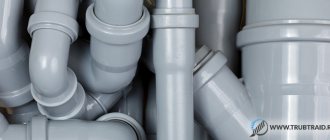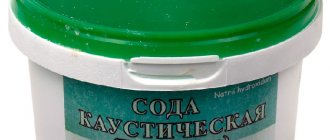Hot and cold water supply systems, in which it is under sufficiently high pressure, sometimes create less trouble than sewer pipe joints. It is through them that water flows by gravity, due to a certain slope of the pipes, from the kitchen and bathroom to the main riser, usually located in the toilet. If the sealing of sewer pipes is done efficiently by builders, then over time the sewer can only be clogged by fat, which accumulates in the water during operation. them. Sealing pipe sockets using the traditional method. Problems with cleaning sewer pipes But it also happens that no chemical solvents intended for this purpose help clear a clogged pipe.
Then it remains possible to clean the pipes mechanically or by water hammer. Mechanically, through a special inlet, which should be located at the end of the pipeline (usually under the sink in the kitchen), you can try to clean the pipes yourself, but for water hammer you will have to invite specialists with the appropriate equipment. If the kitchen is not equipped to special order, then the craftsmen have access to a joint to connect the sink with sewerage and inlet for cleaning. Otherwise, to get to the joints, you will have to move the kitchen structure or even dismantle it.
All of the above has one goal - to convince the owner, who has decided to make repairs in the apartment, to pay maximum attention to the correct installation of the sewer system and assemble it efficiently, as well as to perform reliable sealing of the joints. Why is sealing of joints so important? The sealing process should be taken quite seriously right away, so how work is carried out with pipes, in contrast to exterior finishing, for example, the defects of which are quite easy to fix. Broken joints of sewer system pipes during the repair process should be carefully sealed so that sewage does not enter the apartment and does not create an unpleasant odor. The tightness of the joints and their quality sealing is important in two ways: so that sewage does not get into the ground; so that groundwater does not get inside the joints and then into the sewer pipes. In this case, we are talking about a system of pipes of a sufficiently large diameter and length, which are assembled into a single structure. First, it is advisable to assemble the individual links and then connect them. Working with such pipes is difficult, and correcting a previously made mistake (especially if the pipes have been waterproofed) practically means doing the same, if not more, amount of work. Materials for sealing Tapes for sealing are available in both regular and foil versions. Regular and foil tapes recently used for sealing and corrosion protection of linear pipe elements, plugs, inserts, bends and rotary corners.
To some extent, where necessary, they also provide waterproofing of joints. They are made on the basis of polyethylene, therefore they are dielectrics. These tapes are quite durable and have a long service life.
The disadvantage of films is that they need to be protected from exposure to sunlight. Therefore, it is not advisable to use them in open areas of the sewer system without protection from sunlight. Waterproofing of sewer pipes in underground communications is carried out using liquid rubber. Silicone or fluoroplastic O-rings are operational at temperatures from -60°C to +300°C.
There are special O-rings that seal the joints between plastic and cast iron pipes. Silicone sealants are perhaps the most common material used for high-quality sealing of sewer pipes made of metal and plastic. Depending on the hardener, they are divided into acidic (cheaper) and neutral. Acid sealants should not be used for pipes made of metals, the surface of which may react with acids.
Neutral sealants are universal. For filling the sockets of ceramic pipelines, petroleum bitumen and asphalt mastic are used; for joints of cast iron pipes, technical sulfur is used, previously crushed and heated to a liquid state. The sockets of cast iron pipes are minted with asbestos cement mixed with Portland cement. For the same pipes, the well-known resin strand, jute and hemp cords are used. A reliable seal at the joints can be created using linen plumbing tape or cords pre-impregnated with resin.
At home, sewer pipe joints are sealed with epoxy resin. Sealing methods Scheme for sealing pipe joints. Let's consider some methods for sealing sewer joints in an apartment. The most common type of sewer system in our apartments: it starts in the kitchen, passes through the bathroom and ends in the toilet. In the toilet it is connected to the main riser.
Here the toilet is also connected to the riser. Perhaps, having disconnected the toilet and sewer pipe from the riser, you will be convinced that the pipes were quite easy to separate, the surface of the cast iron joints of the main riser is smooth and in good condition. It seems that the main riser does not need to be changed, and the insertion of corrugated plastic pipes (“accordions”) into it can be sealed using special rubber rings, which we mentioned earlier. If the surface of cast iron joints does not allow the use of transition rubber rings, then sealing can be done using the embossing method. Embossing is performed in the following sequence: insert a plastic pipe into the riser; in the area of the joint, a linen plumbing winding is wound onto the plastic pipe in several layers; pushing it in with a screwdriver with a wide blade ( or a narrow spatula) winding into the gap between the pipe and the entrance to the riser, creates a reliable seal; for reliability, the winding seal is coated several times with a mixture of asbestos cement and Portland cement. The mixture should be filled with water immediately before coating the joint.
After sealing it, it is advisable not to use the sewer for 24 hours. However, during major renovations in an apartment, it is advisable to replace everything, right down to the main riser in the toilet. In this option, the toilet can be connected to the main riser using “accordions”, and the joints can be sealed with a rubber ring and any sealant. To guarantee, the joints should be tightly wrapped with tape containing an acidic or neutral hardener. Share a useful article: Similar articles:
Experts identify several reasons why a sewer pipe leaks:
- damage to the element; manufacturing defect of the tubular product; lack of sealing of the joints.
Mechanical damage to the sewer system is fraught with major repairs - replacement of the entire pipe or part. In other cases, minor repairs are carried out.
Recommendations from experts
If the reason why pipes are leaking is a broken joint seal, you should:
- Dry the joint thoroughly. Clear away debris, blockages, old sealing substances (cement, glue). Choose what to seal the sewer pipe with (the joint of an apartment sewer pipe can be sealed with linen wrap). Sealing the bathroom pipe. Time to dry the element - at least 5 hours (it is not recommended to use the sewer during this time).
The reason why the sewer leaks is a crack in the coating. If the problem is that the solution is cracked, it is recommended:
- Dry the area where the pipe element is leaking. Choose what to cover the damaged area with (leakage can be eliminated with silicone, epoxy solution, liquid rubber, plasticine).
Before you repair a crack in a cast iron sewer pipe, you will need a heat gun. Shallow longitudinal cracks that expose a cast iron pipe to leakage most often occur against the background of frequent temperature changes. In such a situation, experts recommend degreasing and drying the crack with a hair dryer. The system can be sealed with sealant.
Then it is recommended to lay a heat insulator. Through cracks in the cast iron sewer system are sealed with a special two-component glue (cold welding method). After hardening, the seam can be sanded and painted over. The joints of cast iron elements are processed using: spun windings; sediment of strands; the use of asbestos cement and its solutions.
Silicone sealant
This paste-like composition includes rubber as the main component and other substances, which ensures high-quality processing of joints.
It is worth noting that the adhesion of silicone sealants is characterized by high rates. Therefore, its application does not require additional surface treatment with special primers.
Depending on the type of hardener, such sealants are divided into acidic and neutral.
Acid
Such compositions are characterized by low cost. However, they can only be used on certain surfaces. For example, such products are not suitable for sealing pipes through which acid moves.
Neutral
This type of material is considered universal. They can be used to seal plastic and metal sewer products. Silicone paste that has undergone a vulcanization process has a consistency similar to rubber.
To avoid complications when squeezing out the sealant, it is recommended to use a mounting gun. If it is missing, you can insert the hammer handle inside the tube and press on it. The handle will act as a piston.
Step-by-step work execution
Damage to a cast iron product on a straight section is fraught with severe leakage. It is recommended to eliminate a leak in a sewer pipe only after cleaning the element to bare metal using:
- A rubberized clamp (factory or homemade). A piece of fabric impregnated with varnish or epoxy glue. Patches made of fabric, covered with a rubber strip and tied with wire to the pipe.
Before eliminating a sewer pipe leak, you will need to dismantle:
- Trimming the pipe unit with a grinder to the joint. Cleaning the socket from packing, cement, glue. Creating a stop for the lever using a grinder on the remaining part of the pipe. Installing an adapter coupling in the socket. Installing a new pipe in the adapter coupling and fixing it.
If a pipe is leaking due to a fistula, then the system must be repaired using a small wooden chopper or lead cone. The sewer pipe is wrapped with rubber or a bandage; impregnate with epoxy or use a clamp. If the system has not been cleaned, then the hole is sealed with sanitary silicone. It can be used to seal the joint between the pipe and the wedge.
It will take 2-3 hours for the joint to dry. To speed up this process, you can use a hairdryer. Before hammering, the chopik is wrapped with polyethylene from a regular bag. For tight installation, it is processed with a plane. The material of the chop can be not only wooden, but also plastic.
A rubber gasket is put on such a plug. For reliability, it is glued to the gasket with sanitary silicone. The current element of the sewer system can be sealed with gum arabic - liquid glass or office silicate glue. It is also used to process the pipe joint.
Cement
Sealing the joint with cement
When sealing a cast iron socket, Portland cement can be used. This substance dries quickly and provides reliable protection against leaks and accidents. For sealing, a high-quality grade of Portland cement is used. When working with Portland cement, it is necessary to apply the mixture over the joint.
A plumber's wrap is applied to the end of the pipe, and resin strands can be used for thick channels. The end is inserted into the socket, compacted and filled with Portland cement. This design will last for many years.
True, when dismantling it, your followers will have a lot of difficulties. But that is another story.
Additional work
Mechanical damage to the elements of the sewer system is eliminated by replacing the damaged area with a whole one. To do this, you will need the following tools: a hacksaw, flax, pipe wrenches, putty for sealing, a coupling, a pipe cutter, a union nut.
Step-by-step repair work:
- Preparing a new element (must have a leakage of + 30 cm). Unscrewing, removing the cut piece. Threading on the old pipe. Screwing the coupling onto a stationary pipe. Threading on a new product. Seal the thread with flax and putty. Connecting a new piece of product with the old one using a pipeline coupling and a union nut.
Urgent repair of a pipe product can be done using rubber from a bicycle inner tube and coupling.
This will protect against sewer leaks until major repairs. If a plastic pipe is damaged, then it cannot be repaired. It is being replaced by a new analogue.
Light damage to the plastic is covered with a sealant.
For additional reliability, shaped parts are cut in; tees are suitable. All deformed seals at the junction are replaced with new analogues, having previously been lubricated with silicone. Using the recommendations described above, you can easily and quickly eliminate a sewer leak in your apartment before the plumber arrives.
Joining sewer pipes, as a rule, should not cause difficulties. After all, most sewer systems are now made of plastic pipes, which are not difficult to connect with rubber cuffs.
To be precise, PVC pipes are now more often used for sewerage. Other polymer materials (polyethylene, polypropylene, butylethylene) are not so popular and are used less frequently. No matter what kind of pipes the sewer system is installed from, you need to remember that this is a responsible job, and it needs to be done correctly.
And the most important thing in the sewer system is the docking point. If a plastic pipeline is properly designed and installed, it will last a very long time. And thanks to the wide variety of fittings, you can assemble a plastic sewer pipeline of any configuration and for any conditions.
Cast iron pipes faded into the background. They have many disadvantages - price, weight, complexity of installation, and a tendency to become fouled inside with sediment. Plastic pipes, and in particular PVC pipes, on the contrary, are lightweight, cheap, and durable. The main disadvantage of PVC pipes is noise, which must be eliminated at the design and construction stage.
The toilet is leaking - what to do?
Once a leak is discovered, something needs to be done. On the one hand, you can turn to specialists for help who, having the necessary knowledge and experience, will quickly determine the cause of the leak and eliminate it. But they will demand money for the work. On the other hand, if you don't want to pay, then roll up your sleeves and get to work. This article was written for you, adherents of independent repair work.
And remember! The work of a professional plumber today costs almost as much as the toilet itself.
First of all, turn off the water. Make sure to do this, because otherwise additional difficulties may arise. The water enters the tank under pressure, and if something breaks, don't be surprised when it starts gushing out in the middle of the room. Your next step will be to find the faulty toilet part. This will require patience and several working tools.
The toilet is leaking
Fittings for joining sewer pipes
Fittings are connecting and auxiliary elements of pipes.
Sewer pipes use their own fittings. With the help of fittings, you can make pipeline turns, bends, connect external pipes, change the diameter... etc. In general, they are needed to turn ordinary straight pipes into a complex pipeline.
For example, this is how fittings are used to solve a typical problem: connecting a sink and toilet on the same branch to a riser.
A pipeline with a smaller diameter of 40 or 50 mm is suitable for the sink, while the toilet is connected with a diameter of only 110 mm. PVC fittings and pipes have a fixed diameter, which is determined by GOST. For the construction of sewerage systems in private houses and apartments, the following diameters are applicable: 22, 32, 40, 50, 110, 150 mm. What types of sewerage fittings are there? The cross is the most complex pipeline connection (4 bends). Bends can be located in one or two planes at an angle of 45 and 90 degrees. Tees - necessary for creating pipe bends. The bend angle can be 45, 60, 90 degrees. Angle - for creating pipeline turns - 30, 45, 60, 90 degrees.
(Advice - you should not make turns of the sewer pipeline with a 90-degree angle, due to the increased likelihood of creating a blockage in this place. Such an angle is better assembled from successively installed angles of lesser bend. An example of installation is shown in the figure.) Plug - covers the end part of the pipeline Revision - coupling with a closed hole, necessary to ensure inspection and cleaning of the pipeline, installed in places of branches and turns. Reduction - for joining pipelines of different diameters. Check valve - serves to prevent the reverse movement of liquid through the pipeline. Plastic pipe fittings are also divided into external ones - for installation external sewerage (painted red), and internal - for installation of sewerage inside the house (gray). Basically, the joining of plastic sewer pipes is carried out using rubber seals. These seals are inserted into the rim of the socket of a pipe or fitting.
But there are also fittings and pipes intended for connection with glue, although they are practically not used. For adhesive joints, rubber seals (cuffs) are not needed. It happens that it is necessary to join pipes made of different materials, old and new. In this case, you cannot do without special joining techniques. Let's consider what other materials and methods are used to seal joints of sewer pipes. Sealing joints All joints of sewer pipes must be sealed most carefully.
The costs of repairing an underground sewer system are comparable to the costs of installing a new system. Therefore, it is important to do everything very reliably at once. Silicone sealants are used to seal sewer joints. These are multicomponent compounds. Among other things, they may contain acid (cheaper types) or be neutral.
Acidic silicone sealants cannot be used with metal. Therefore, when selecting a sealant for sewer installation, you should always correlate its properties with the type of pipes being joined. It is also recommended to treat the joints of plastic pipes on rubber cuffs with sealant. This will make the connection reliable. But you can’t do without sealant when it comes to connecting to cast iron pipes with any adapters. The sockets of a cast iron pipe cannot be too even, and always require additional sealing with flowing materials.
A silicone-based sealant will best cope with this. Instead of sealants and rubber seals for other types of pipes, it is recommended to use time-tested, reliable methods for joining sewer pipes. The following methods can be used to seal joints. Filling a joint with epoxy glue is a very reliable connection of pipes, but the joint is it will no longer be possible to disassemble this, since the pipes will stick together. Seal the pipe in the socket with hemp rope or resin strand for 70% of the inserted length and then fill the remaining gap with cement mortar (or asbestos-cement 1:1). This is a very old method of joining cast iron pipes. It can be used with any type of material, including in places where pipes made of different materials are joined. The use of technical sulfur for filling the sockets of cast iron pipes is also not excluded. This is how sewers were built quite recently. Bitumen mastic can also be used for external sewer pipelines.
It is often used to fill ceramic pipeline joints. Various sealing tapes can also be used for sealing. But such sealing is more likely to be repair or temporary. In general, it is clear that joining a sewer pipeline with your own hands will not be difficult. And the result can be even better than if strangers did it. How to eliminate a leak in the sewer During operation, a leak may occur from the sewer pipeline. The reason is often careless installation, or incorrect design (laying) of the pipeline.
But a leak can also be due to manufacturing defects in the pipe itself or due to mechanical damage. But before starting repairs, you need to stop using the sewer, dry the leak site, clean it and degrease it. After this, the repair will be of high quality. But even after the repair, do not forget to wait the time necessary for the adhesives to harden - it will be 2 hours or a day. The following damage to the sewer pipeline and methods for eliminating leaks are possible: 1. Leaks at pipe joints.
It happens that the caulking of old sewer pipelines becomes unusable. In joints covered with cement mortar or sulfur, gases or even liquids escape from the sewer. Such leaks at the joints can be sealed with an adhesive-binding composition. The best solution is either a sewer sealant or a mixture of cement mortar and PVA glue. The cracked layer is removed, cleaned, and existing cracks are expanded using a sharp tool. Next, an adhesive composition is rubbed into the cracks. In addition to these compositions, epoxy glue or other waterproof glue, raw rubber, even plasticine are also suitable.2. There is a round hole in the pipe.
A small hole of the correct shape is often sealed with a wooden peg treated with sealant. The only thing is that the peg should not go far into the pipe so as not to block the cross-section. Another way to seal a hole is to apply a tire to the pipe. The easiest way is to wrap the pipe with cloth soaked in epoxy glue. Such repairs will be durable.
But you can also apply a tourniquet of raw rubber (rubber bandage) by wrapping wire on top of it. You can also reliably eliminate a leak using a clamp on a rubber gasket. But given the diameter of the pipeline, the cost of such a clamp will be significant. 3. There is a longitudinal crack in the pipe.
Of course, everything depends on the size and configuration of the crack. It may well be that tying the pipe with a bandage with epoxy glue will help out. Or maybe just a sealant wrapped in a crack in a cloth will do. For more severe cases, you can use a special repair compound for metal - cold welding. This is actually a two-component adhesive that gives strong connections just on metal.
If we are talking about plastic, then epoxy is naturally better suited.4. The edge of the socket, or a significant part of the pipe, has chipped. There may be a situation where sealing is no longer able to help. Then call a plumber and consult with him - how to repair the hole, or start replacing the pipes. But in order not to have to make such repairs to the sewer pipeline, it must be properly designed and laid, as well as the joints must be properly sealed. Even in the case of a recently laid sewer system made of plastic pipes, not to mention old cast iron pipelines, sometimes there is a need to repair sewer pipes pipes. Crack in pipe
Using self-adhesive tape
This material appeared on the construction market relatively recently. It was specially manufactured for processing sewer joints. This sealant comes in the form of a white tape of varying widths wound around a spool. Each manufacturer independently sets the values of this value.
The advantages of self-adhesive tape include the following:
- ease of operation;
- corrosion resistance;
- high insulating properties;
- increased reliability.
Among the disadvantages of this product are instability to ultraviolet rays, as well as the inability to use it for treating open sewers.
If it is necessary to create an airtight connection directly on the street, the place on which this film is glued must be covered with any sun-protective material.
Professionals use this product for other purposes, for example, when they need to create a reliable connection of fittings and other fittings.
Depressurization of the joint
Most often, a sewer pipe leaks at the pipe-siphon connection (washbasin, bathtub, sink).
Having disassembled the joint and the siphon, you need to clean and rinse the components and replace the sealing gaskets. After assembling the elements and tightening the connection, check the tightness. If the leak is not eliminated, then it becomes necessary to replace the rubber seal at the entrance to the pipe.
A leak that occurs at the junction of plastic pipes can be easily eliminated by replacing the rubber seal. To more reliably seal the joint, you can use silicone pipe sealant.
If the system is made of cast iron, then more complex repairs of sewer pipes will be required.
Cast iron pipe connection material:
In the first case, disassembly and assembly are carried out in the following sequence:
- Remove old cement using a chisel and hammer. Pull out the packing. Place a new layer of packing. Pour in a cement solution prepared in a ratio of 5:1 (cement:water).
Dismantling and installation
How to seal a sewer pipe if you don't have liner or asbestos? You can use “available” materials.
You will need:
- Medical bandage. Cement. Liquid glass.
Repair sequence:
- Preparing the joint (cleaning, removing the sealant). Making a solution from cement, water and liquid glass. Wetting the bandage in the solution and wrapping the joint. Concealing defects and additional sealing by coating with paint.
Repair with improvised materials
If the joint is sealed with lead, then it is necessary:
- Clean the surface. Hammer lead cones into the gap using a chisel. The softness of the metal allows for easy driving.
Condensation on the drain tank
If none of the above problems apply to you, then perhaps it is not the plumbing that is leaking, but condensation that has formed on it. This often happens - droplets of moisture can often be found on the toilet, especially in the summer. Of course, condensation on the toilet will not flood your neighbors, but their ceiling will most likely become damp.
You may be interested in information on how to repair a toilet cistern
Condensation can form because the water and air in the room have different temperatures or because the drain tank has failed.
Sometimes condensation appears immediately after installing the toilet and this is eloquent evidence of the low quality of the product. So let's look at a few examples that can help you understand the cause of the problem.
- It happens that the water does not drain from the tank for two to three hours, which is why it heats up to the air temperature. In this case, the condensation disappears, but provided that the tank is working normally.
- Sometimes the hood is to blame, but then there must be condensation on the pipeline. Examine it.
If there is condensation on the pipes, then the problem is most likely in the hood
The condensation problem can be solved in one of the following ways:
- reduce the frequency of draining the tank;
- reduce humidity in the house;
- raise the temperature of the water entering the cistern.
- change the tank itself, but only if you are firmly convinced that it is faulty.
Crack in a sewer pipe
The solution to this problem depends on the pipeline material:
- The sewage system is made of plastic pipes and fittings. A crack in a polymer sewer pipe is sealed with sealant and wrapped with tape. The pipeline is made of cast iron. A crack in a cast iron sewer pipe is eliminated as follows: Degrease the surface, having previously widened the crack. Prepare a mixture of phosphoric acid and copper oxide (1:1.5). Cover the crack, taking into account that the mixture hardens very quickly.
If you need to make urgent repairs to a sewer pipe, you can use metal clamps with a rubber gasket.
An alternative would be sealing tape.
Cold welding
Cold welding is a mixture of epoxy resin with special fillers. They give the created product the required qualities, including strong surface adhesion. Thus, the roughness present on the attached surfaces only contributes to their more reliable adhesion to each other.
In appearance, cold welding resembles two-color plasticine. Before use, you need to knead it and mix both colors until you get a uniform shade. Then this mixture should be pressed as quickly as possible onto the leak area that has been cleaned to a shine, dried and thoroughly degreased.
One of the significant advantages of this material is its excellent adhesion to surfaces on which moisture is present. Thus, if a sewer pipe is leaking at a joint, the use of cold welding allows you to quickly seal the existing leak.
Cold welding will help quickly fix a problem in the sewer system
A connection created in this way will become reliable after 1 ˗ 24 hours. The exact time depends on the amount of material used and temperature conditions. But in any case, for this period you will have to stop using the sewer system.
Clogged sewer pipe
Since the sewer system, when installed correctly, is self-cleaning, blockages can occur almost only in siphons.
Ways to clear congestion:
Using hot water.
Add dishwashing detergent to boiling water and pour it into the clogged plumbing fixture. You can use a plunger to clean the clogged area from foreign matter. The vacuum it creates will help break through the jam. Cover the overflow hole in the plumbing fixture with a thick cloth during punching.
Cleaning with a plunger
Use of chemicals.
Chemical cleaning agents should be used according to the instructions. Use a cable by inserting it into the drain insertion point or into the inspection outlet. When the handle rotates, the cable deepens into the blockage and loosens it. For complete cleaning, use hot water and detergent.
Washing with a sewer washing machine.
A large amount of water under high pressure is supplied to the pipeline, which leads to pushing the blockage into the sewer well. This method is used in private homes. Cleaning using a robot equipped with a video camera. Video diagnostics of a sewer pipe allows you to determine the cause of the blockage and decide how to eliminate it.
A method such as tele-inspection of a sewer pipe, due to its high cost and the use of special devices, has not yet become widespread in the CIS countries.
Technical sulfur
Sealing an old cast iron drain can be very difficult. Technical sulfur was often used to repair cast iron pipes. But to apply it, it was necessary to heat the composition to a plastic state. A special vessel was used (bath for heating sulfur).
The material is pre-melted in an electric furnace at a temperature of 130-135˚C, and then poured into the socket. Unfortunately, the repair may be of poor quality if it was not possible to fill it at once.
Observing special precautions will help you avoid unpleasant consequences when working with sulfur, since the sealant easily spills, and careless handling leads to a chemical burn.
In addition to the high temperature and risk of fire, there was another risk factor during such work - toxic gas was released during combustion. Therefore, I had to work in a respirator. Nowadays, pipes can be sealed in safer ways, so technical sulfur is practically not used.
Repair of external sewerage system
How to repair sewer pipes if they are located under an asphalt road? In this case, a trenchless repair method is used using polymer pipes. The advantages of polyethylene pipes (high strength, light weight, long service life) allow them to be used for such repairs.
Types of trenchless repair:
Answers from experts
Contemplador SA:
Try crushing slate (or finding asbestos) and diluting PVA. In dry weather, you need to carefully coat the gap around the pipe, maybe in several layers, waiting for the previous layer to dry. It happened that we repaired broken slate along the wave of the sheet - it held up for years. You can also apply it from the inside, if it’s convenient to approach.
Stalin:
now it's too late... As a temporary option, cover with foam.
Pavel Nasonov:
In the barn I just filled it with resin and painted it, but in the house it would be nice to put a box on the pipes. You can also use sealant
Denis Astanin:
to make an “otter” from galvanized steel, in other words, take a sheet of tin, make a square cutout in it with sides smaller than the base of the pipe by 10 centimeters, cut the corners and bend the sides of the cutout up to form “springboards” that go out onto the pipe, and put this on accordingly structure on the base of the pipe at the junction with the slate
MaGuchiY:
remove the old mortar, prepare a mortar - sand + cement 1 to 1 thicker surface, moisten with water, clean from dust and add a little liquid glass to the prepared mortar and immediately re-coat it.
Victor*73:
Denis is right...it is necessary to galvanize the “tie” on the pipe
foreman:
Make a frame for the galvanized pipe from the inside under the roof, then let your imagination and wallet size fly: making a clay seal (the cheapest option), polyurethane foam (it crumbles over time), construction mastic (cool thing!!! doesn’t dry out, elastic!!!)
Andrey:
Galvanized metal. And only so! Everything else is useless daub. Here's an example of how it should be:
Petrova:
There is a special sealant just for this purpose. It seems to be called “Moment”, but this is not certain.
Zhenya Rodin:
no, asbestos cannot be used with foam, or mineral wool can be used; it does not burn. there are also fireproof solutions
Victoria:
there is an old, but very reliable and proven method, and the main thing is very simple: you take women's tights, pour the solution into them and seal them, the solution does not spill out and holds up perfectly, the tights serve as a mesh and additional reinforcement. I also had one stove-maker seal this way and another one master, 7 years have already passed, no problems. The foam will not hold; it will lose its properties over time; it is not reliable, and it will probably burn; the pipe will heat up.
Ukraine 2000:
What is the chimney made of? About 3 years ago I installed a boiler and ran the galvanized pipe through slate. There was a gap, I bought something very reminiscent of bitumen at a construction market. I also melted it, poured it, and pah pah there were no complaints! It doesn't even crack!
Yuri!!!:
don’t even think about it, it burns, it’s generally sealed with roofing cutting, but they also sell special caps, a very convenient thing, but I don’t remember what it’s called)))
MARISHKA SUNSHKO(=:
I had such a piece of iron, and every time the roof leaked, when it rained, water flowed through the pipe, it just leaked and there was a stain on the ceiling, until they repaired it with a solution, nothing helped,
hunter:
In this photo there is no otter extension on the pipe that prevents water from entering; the distance between the pipe and the roof must be at least 40cm. which is sealed with felt or asbestos, and only then with stainless steel as in the photo. Look for accurate information on the websites of stove makers.
Reef:
You can’t use foam, it will melt at high temperatures, don’t risk it)))
Alexander Barinov:
if the pipe is brick - foam
Yura Malyshev:
Pleshakov is right. His option is the most reliable.
Steel
I most often use steel pipes for laying water pipes. Over time, damage to welds, bends, and threads can be observed. Under the influence of corrosion, the formation of pores, cracks, and holes can be observed in the risers, through which water begins to leak. At first you cannot even notice the location of the damage. Therefore, you need to remember: the presence of a damp section of the wall or floor is a guarantee that it is necessary to thoroughly inspect the water supply system.
Let's look at several ways to seal a crack in a steel pipe.
- This repair option requires epoxy resin and fiberglass. First, you need to completely get rid of the water in the pipe, dry the area of future repair, and clean the desired section of the pipe with a wire brush. There are times when a pipe cannot be cleaned with a brush because it is very close to the wall. Then they do this: take a steel cable, tie small knots at the ends and clean an invisible section of the pipe.
After this, you need to take epoxy, generously lubricate the fiberglass with it, and wrap the damaged area in 4-5 layers. Very important: even small bubbles should not be allowed to appear, since their presence will significantly reduce the quality of the winding. If fiberglass is not available, then cotton or linen analogs are used as a replacement, but not synthetic ones. For greater confidence, it is necessary to tighten the winding with a clamp or, if it is missing, wrap it with wire. Epoxy resin can be replaced with “iron putty”. Its composition: iron filings - 250 g, powdered ammonia - 6 g, powdered sulfur - 3 g. Mix all ingredients thoroughly until a homogeneous mixture is formed (consistency - plasticine). - If a leak is eliminated if there is water in the riser, proceed as follows. First you need to make a plug from lead, wood or rubber, fill the hole with it, and wrap the repair area with regular electrical tape. Then apply 4-5 layers of thick fabric or tape on top, pre-treating them with epoxy resin or whitewash.
- You can get rid of a leak if you tightly wrap the damaged area with rubber and put a metal clamp on top.
- In case of major damage, use the so-called “cement box”.
It is a case made of boards, which is filled with a solution of sand and cement in a ratio of 2:1. To make it “set” faster, dilute the mixture with “liquid glass”, the amount of which is determined by sampling.
This method is very effective when there is water in the riser. To do this, before filling the box with solution, you need to tightly attach a thin tube to the hole. If, after filling the case with the solution, clean water flows from the tube, then everything is done correctly. After some time, the mixture in the box will harden, and the water should also be clean. Only after this you need to tightly plug the tube with a stopper, for example, wooden or rubber.
The ideal option for getting rid of a leak in a steel pipe is using electric or gas welding, if possible.
